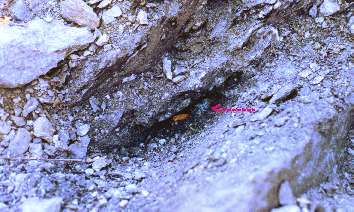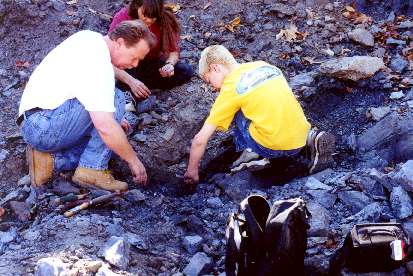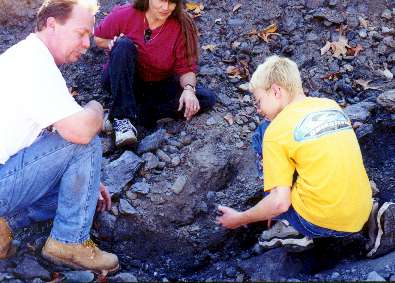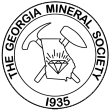"The Mystery of the Blue Stone"
by
Dr. David Babulski

One of our new GMS members, Bill Spencer, called me to see if I could help identify a mineral that he found at a construction site off of Peachtree-Industrial Blvd. In Gwinnett County. We agreed to meet on a Saturday morning near the site. He showed me a coffee can full of a beautiful sky blue mineral lining vugs in what appeared to be a graphite schist. Bill had tentatively identified the mineral as Chrysocolla. Well I was intrigued as Chrysocolla would be a rare find for Gwinnett County. So off we went to visit the site.
Geologically, the site is located just inside the Brevard Fault Zone on the northern edge of the Wolf Creek Formation. Geographically, the site is just south of the city of Duluth, Georgia. The host rock is thinly bedded, highly foliated, graphite schist with abundant pyrite. (I believe another GMS member had reported this site).
The light blue mineral was found as a pod that looked like a secondary fracture filling as it cuts across the general strike and dip of the host rocks. We collected as much of the mineral as we could. My thinking was that this blue mineral could indeed be Chrysocolla or perhaps one of the iron or copper sulphates that are common in the area. I knew from a previous investigation that Chalcopyrite is present in the Wolf Creek Formation. If the mineral was confirmed as Chrysocolla, the Chalcopyrite could be the source for the copper.
I brought back some samples to my lab at home and did some tests. I found that the mineral was not soluble in water. This eliminated many of the iron or copper sulphates. The borax bead test was positive for copper (green cold bead, blue hot bead). Testing with the harness points put the mineral in the hardness range for Chrysocolla as did its physical appearance, that of no visible crystal structure and botryoidal habit. The charcoal block test was interesting! Roasting a bit of the crushed mineral in the blowpipe oxidizing flame produced a faint white sublimate on the block. No green color to the flame. Back to that faint white sublimate in a minute. Moistening the roasted mineral with HCL (hydrochloric acid) and re-heating produced the characteristic azure blue flame of copper chloride. Another positive test for copper!
Everything was pointing to Chrysocolla except for that faint white sublimate on the charcoal block. Looking at the mineral very carefully through the stereo microscope revealed a thin coating of micro-crystalline gypsum covering the light blue mineral. In fact I found some small vugs lined with micro crystals of gypsum. I believe it is the sulfur component in the gypsum that was causing the white sublimate on the charcoal block. The mineral lokks to indeed be Chrysocolla. Also found with this mineral were several small pods of Bornite as well as crystals of pyrite. All-in-all a very enjoyable mineral detective story using the “old ways”. A check of the mineral literature shows this is only the second reported occurrence of Chrysocolla in Gwinnett County.
Photographs by Dr. Babulski


BILL SPENCER AND FAMILY

Copyright © Georgia Mineral Society, Inc.
